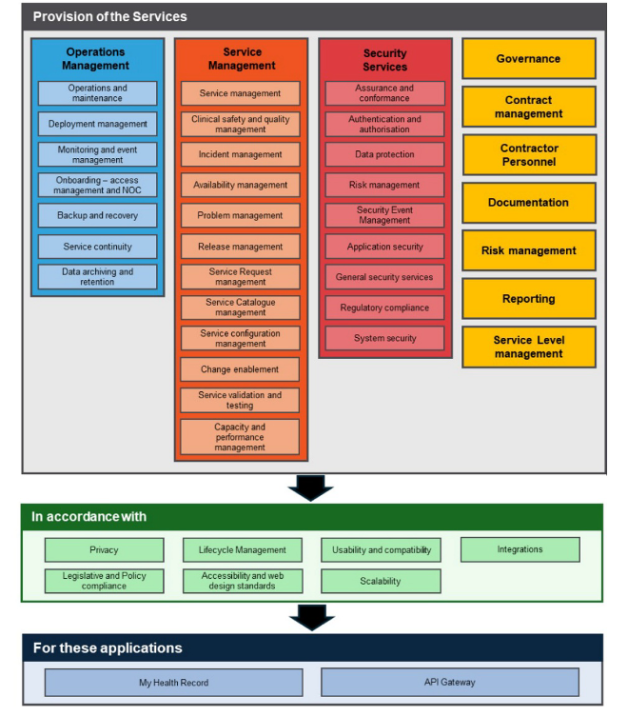This is a big one – it’s all about making the My Health Record infrastructure modern, secure, scalable and sustainable.
The Australian Digital Health Agency has published a Request for Tender via AusTender to secure “application support and maintenance (ASM) services for digital health infrastructure which includes My Health Record” and the API gateway.
The RFT is the next step in a timeline which began with a request for information process in November 2024, the feedback from which “advanced the Agency’s understanding of current technology, process improvements and innovative service solutions available in the sector” and was directly leveraged in the development of the RFT, according to the tender documents.
While no dollar figures are mentioned in the RFT documents, ADHA CEO Amanda Cattermole described it as “a significant milestone towards better enabling better coordinated care for Australians, and for healthcare providers to be able to collaborate and share information more easily across a wide variety of settings and geographical locations”.
“The ASM services are a cornerstone of the agency’s ongoing transformation journey, supporting our current suite of digital health products and paving the way for innovative solutions,” said Ms Cattermole.
“New ideas and approaches are essential as we advance towards a future-ready, connected healthcare system.”
The timeframe for delivery of the ASM services is listed as three years from April 2026.
John Borchi, the ADHA’s chief technology officer, said the feedback from the RFI had underscored the need for “a holistic, scalable, adaptable, stable and highly secure operation”.
“This tender represents a critical opportunity to contribute to Australia’s digital health landscape, ensuring we remain a global leader in innovation and healthcare,” said Mr Borchi.
“The RFT will enable the delivery of modern systems and provide support for the fast-changing digital health ecosystem.”
According to the documents available on AusTender, the key objectives of the RFT are:
- ensuring the people of Australia (including health providers) can continue to access their health information on a stable, high performing and highly available system;
- supporting the agency’s agenda to transform the digital health infrastructure by moving to a contemporary, structured, data-rich ecosystem capable of connecting systems across settings, and supporting real-time access to information for the patient and the broader care team – anywhere, anytime;
- ensuring alignment with the agency’s modernisation agenda to ensure the stabilisation of the digital health infrastructure during its transformation;
- to ensure alignment with the agency’s clinical governance framework;
- to ensure alignment with the agency’s legal obligations as the system operator of My Health Record;
- to ensure alignment with the agency’s Cyber Security Strategy and the Protective Security Policy Framework (PSPF); and
- to ensure alignment with the agency’s strategic approach to streamlining service integration activities, implement service integration and management (SIAM) and simplifying the service provider ecosystem.
A virtual briefing for interested organisations will be held at 2pm AEST on Thursday 7 August – more information is available here.
“As ASM services are procured and developed in 2025–26, the continued, secure, reliable operation and maintenance of the My Health Record system will be supported by a transition contract with the incumbent supplier,” said the ADHA announcement.
Related
“This is a critical underpinning as the Agency moves towards modernised national digital health infrastructure products and services that, together, provide real-time access to health information for Australians and care teams anytime, anywhere.”
The RFT documents said the successful contractor would be required to provide the services as identified in the figure below:

Those services would be provided across the application system components identified in the figure below:

The RFT documents require the contractor to ensure that the application system components are “scalable, with the capability to add extra capacity as the demand for access to the My Health Record System increases”.
“The My Health Record System currently stores 28 million clinical documents, 64 million prescriptions and dispense documents, 240,000 consumer documents, 1.3 billion Medicare documents and has 16,400 provider organisations registered,” it said.
The successful contractor must also:
- adapt to emerging digital health standards (such as FHIR) and other frameworks and requirements to advance interoperability as they are agreed and implemented within the digital health infrastructure and national digital health ecosystem;
- work with government departments that operate IT services and national infrastructure required to be integrated into the digital health infrastructure and more broadly the national digital health ecosystem and ensure they are supported through recognised national arrangements, including the whole of government arrangements; and
- work with third-party vendors to support interoperability between various clinical information systems, mobile applications, and other registered healthcare provider organisation systems.
The ADHA said it was willing to consider hybrid delivery models, including offshore contractor personnel, provided those personnel “will not have access to Agency systems, My Health Record data, personal information and any security classified information”.
“Any proposal for use of overseas based contractor personnel will be considered on a case-by-case basis,” said the document.
Read the full set of RFT documents here.
Closing date for tender applications is 2pm ACT time on 24 September 2025.




